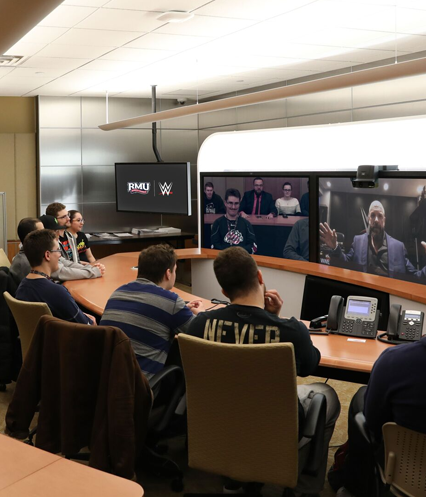Newsroom
Tag Team Teaching
Stars and top executives of the WWE give weekly lectures to students for a new sport management class.

“We covered marketing, entertainment, sports management. It was a fascinating class."
Two weeks after getting body-slammed on television by former mixed martial arts champion Ronda Rousey, Stephanie McMahon smiled into a camera with a live link to a classroom full of Robert Morris University students.
A new sport management class, introduced last spring, takes a close look at World Wrestling Entertainment — where McMahon also is the chief brand officer — and explores how WWE combines sports, business, and entertainment into a multibillion-dollar media company. “Everything in our business is a story. It’s no different than a movie, a play, an opera,” McMahon told students from her company’s airplane while flying to Little Rock on a business trip. “It’s protagonist vs. antagonist with conflict resolution. The only difference is our conflicts are resolved inside of a 20-foot-by-20-foot ring.”
McMahon is one of six top WWE executives who spoke to students during the spring semester class in the School of Business. Another was Paul Levesque — better known by his ring name, “Triple H” — who in addition to his role as executive vice president of talent, live events, and creative is also McMahon’s husband. Other guest lecturers were Jayar Donlan, vice president of social media; John Brody, executive vice president of global sales and partnerships; Canyon Ceman, vice president of talent development; and Matt Bloom, a former wrestler and WWE’s current head trainer.
McMahon, the daughter of WWE CEO Vince McMahon, was already invested in the region as a board member of Children's Hospital of Pittsburgh. She was attending a local reception for participants in the Aspen Institute’s Henry Crown Fellowship when she ran into another fellow, RMU President Chris Howard. Together they hatched the idea of a college course.
The new WWE class adds an entertainment management component to the sport management curriculum, according to Michelle Patrick, the business school’s dean. “It was one of the best experiences I’ve had teaching,” she says. “We covered marketing, entertainment, sports management. It was a fascinating class.”
“There’s marketing, communications, analytics, event facility management, the sales side,” says David Synowka, head of the school’s sport management department. “It exposed to our students and the faculty just how innovative WWE is.”
Patrick developed and taught the class with Synowka and John Locke ‘03 M’06 D’18, director of student activities and leadership development and a lifelong professional wrestling fan. Locke wrote his doctoral dissertation as a case study of the similarities in the college experiences of athletes and actors — such as how they work in teams in scheduled practices to perform in front of audiences. His thesis caught the notice of
the WWE, and Locke was invited to its sprawling training facility in Florida, where he presented his findings over three days this summer.
McMahon’s lecture to the class came two weeks after WrestleMania. The WWE’s premier annual event was held in the New Orleans Superdome in April, and in addition to her role as an executive, McMahon teamed with her husband in a climactic tag team match there, losing to Rousey and Kurt Angle. For the class, each student followed a WWE star’s story arc leading to WrestleMania. “They had to relate their superstar to what they were learning: storytelling, branding, everything along the way,” Patrick says.
Being able to pull those strings together is among the greatest assets in the business world, according to Levesque. “In life, in the world, everything is storytelling. It’s knowing the audience that you’re in front of,” he told the class during his guest lecture. The plot lines playing out in the ring, the task of scheduling 560 live events into a single year, the enormous undertaking of moving WWE events from city to city, and the ever-evolving marketing and branding of the business combine into the larger story of WWE, he said. “You’re in a classroom where you’re looking at that, and you’re breaking it down into stories and how they’re told,” Levesque said. “That will be of value to you the rest of your life.”
WWE’s larger story is one of a media company adapting to changing times as it expands around the world, McMahon told the class. Those changes are particularly evident for women wrestlers, who were once something of a sideshow but whose storytelling talent and athleticism now are being presented on par with those of the men.
